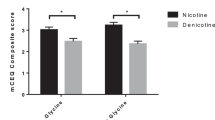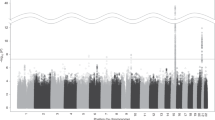Abstract
We have previously demonstrated that a functional dopamine D2 receptor promoter variant (DRD2 −141 Ins/Del) predicts response to nicotine replacement therapy (NRT). The present study extends this finding in the same population of 363 NRT-treated subjects, by examining variation in the gene encoding the neuronal calcium sensor-1 protein (FREQ), which functions to regulate D2 receptor desensitization. The results indicate a statistically significant interaction effect of DRD2−141 and FREQ genotypes on abstinence at the end of the NRT treatment phase; 62% of the smokers with at least one copy of the DRD2 −141 Del allele and two copies of the FREQ rs1054879 A allele were abstinent from smoking, compared to 29–38% abstinence rates for other smokers in the trial. This result suggests that the interaction between variation in the DRD2 and FREQ genes, which both encode components of the D2 dopamine receptor signal transduction pathway, impacts the efficacy of NRT.
This is a preview of subscription content, access via your institution
Access options
Subscribe to this journal
Receive 6 print issues and online access
$259.00 per year
only $43.17 per issue
Buy this article
- Purchase on Springer Link
- Instant access to full article PDF
Prices may be subject to local taxes which are calculated during checkout

Similar content being viewed by others
References
Fiore MC . Treating tobacco use and dependence: an introduction to the US Public Health Service Clinical Practice Guideline. Respir Care 2000; 45: 1196–1199.
Silagy C, Lancaster T, Stead L, Mant D, Fowler G . Nicotine replacement therapy for smoking cessation. Cochrane Database Syst Rev 2004; 3: CD000146.
Hughes J, Stead L, Lancaster T . Antidepressants for smoking cessation. Cochrane Database Syst Rev 2003; 2: CD000031.
Lerman C, Patterson F, Berrettini W . Treating tobacco dependence: state of the science and new directions. J Clin Oncol 2005; 23: 311–323.
Lerman C, Jepson C, Wileyto EP, Epstein LH, Rukstalis M, Patterson F et al. Role of functional genetic variation in the dopamine D2 receptor (DRD2) in response to bupropion and nicotine replacement therapy for tobacco dependence: results of two randomized clinical trials. Neuropsychopharmacology 2005; in press.
Johnstone EC, Yudkin PL, Hey K, Roberts SJ, Welch SJ, Murphy MF et al. Genetic variation in dopaminergic pathways and short-term effectiveness of the nicotine patch. Pharmacogenetics 2004; 14: 83–90.
Lerman C, Wileyto EP, Patterson F, Rukstalis M, Audrain-McGovern J, Restine S et al. The functional mu opioid receptor (OPRM1) Asn40Asp variant predicts short-term response to nicotine replacement therapy in a clinical trial. Pharmacogenomics J 2004; 4: 184–192.
Swan GE, Valdes AM, Ring HZ, Khroyan TV, Jack LM, Ton CC et al. Dopamine receptor DRD2 genotype and smoking cessation outcome following treatment with bupropion SR. Pharmacogenomics J 2005; 5: 21–29.
Bockaert J, Roussignol G, Becamel C, Gavarini S, Joubert L, Dumuis A et al. GPCR-interacting proteins (GIPs): nature and functions. Biochem Soc Trans 2004; 32(Part 5): 851–855.
Bergson C, Levenson R, Goldman-Rakic PS, Lidow MS . Dopamine receptor-interacting proteins: the Ca(2+) connection in dopamine signaling. Trends Pharmacol Sci 2003; 24: 486–492.
Burgoyne RD, O'Callaghan DW, Hasdemir B, Haynes LP, Tepikin AV . Neuronal Ca2+-sensor proteins: multitalented regulators of neuronal function. Trends Neurosci 2004; 27: 203–209.
Kabbani N, Negyessy L, Lin R, Goldman-Rakic P, Levenson R . Interaction with neuronal calcium sensor NCS-1 mediates desensitization of the D2 dopamine receptor. J Neurosci 2002; 22: 8476–8486.
Arinami T, Gao M, Hamaguchi H, Toru M . A functional polymorphism in the promoter region of the dopamine D2 receptor gene is associated with schizophrenia. Hum Mol Genet 1997; 6: 577–582.
Nisell M, Nomikos GG, Svensson TH . Infusion of nicotine in the ventral tegmental area or the nucleus accumbens of the rat differentially affects accumbal dopamine release. Pharmacol Toxicol 1994; 75: 348–352.
Ito K, Haga T, Lameh J, Sadee W . Sequestration of dopamine D2 receptors depends on coexpression of G-protein-coupled receptor kinases 2 or 5. Eur J Biochem 1999; 260: 112–119.
Iwata K, Ito K, Fukuzaki A, Inaki K, Haga T . Dynamin and rab5 regulate GRK2-dependent internalization of dopamine D2 receptors. Eur J Biochem 1999; 263: 596–602.
Redden DT, Shields PG, Epstein L, Wileyto EP, Zakharkin SO, Allison DB et al. Catechol-O-methyl-transferase functional polymorphism and nicotine dependence: an evaluation of nonreplicated results. Cancer Epidemiol Biomarkers Prev 2005; 14: 1384–1389.
Bierut LJ, Rice JP, Edenberg HJ, Goate A, Foroud T, Cloninger CR et al. Family-based study of the association of the dopamine D2 receptor gene (DRD2) with habitual smoking. Am J Med Genet 2000; 90: 299–302.
Spitz MR, Shi H, Yang F, Hudmon KS, Jiang H, Chamberlain RM et al. Case–control study of the D2 dopamine receptor gene and smoking status in lung cancer patients. J Natl Cancer Inst 1998; 90: 358–363.
Lerman C, Kaufmann V, Rukstalis M, Patterson F, Perkins K, Audrain-McGovern J et al. Individualizing nicotine replacement therapy for the treatment of tobacco dependence: a randomized trial. Ann Intern Med 2004; 140: 426–433.
Brown R, Burgess E, Sales S, Whiteley J . Reliability and validity of a smoking timeline follow-back interview. Psychol Addict Behav 1998; 12: 101–112.
Heatherton TF, Kozlowski LT, Frecker RC, Fagerstrom KO . The Fagerstrom Test for Nicotine Dependence: a revision of the Fagerstrom Tolerance Questionnaire. Br J Addict 1991; 86: 1119–1127.
Hughes JR, Keely JP, Niaura R, Ossip-Klein DJ, Richmond RL, Swan GE . Measure of abstinence in clinical trials: issues and recommendations. Nicotine Tob Res 2003; 5: 13–25.
SRNT Subcommittee on Biochemical Verification. Biochemical verification of tobacco use and cessation. Nicotine Tob Res 2002; 4: 149–159.
Mander AP . HAPIPF: STATA Module to Perform Haplotype Analysis. Boston College Statistical Software Component Archive. Department of Economics: Chestnut Hill, 2002.
Mander AP . Haplotype analysis in population-based association studies. STATA J 2001; 1: 58–75.
Acknowledgements
We acknowledge Candice Schwebel for administrative assistance and Bernard Lo and Andrew Weller for technical contributions. This research was supported by a National Cancer Institute and National Institute of Drug Abuse Transdisciplinary Tobacco Use Research Center grant P5084718 to CL. JPD is supported by a National Institutes on Drug Abuse Fellowship Grant # T32 DA07241-12. Dr Berrettini is a consultant to Glaxo Smithkline.
Author information
Authors and Affiliations
Corresponding author
Rights and permissions
About this article
Cite this article
Dahl, J., Jepson, C., Levenson, R. et al. Interaction between variation in the D2 dopamine receptor (DRD2) and the neuronal calcium sensor-1 (FREQ) genes in predicting response to nicotine replacement therapy for tobacco dependence. Pharmacogenomics J 6, 194–199 (2006). https://doi.org/10.1038/sj.tpj.6500358
Received:
Revised:
Accepted:
Published:
Issue Date:
DOI: https://doi.org/10.1038/sj.tpj.6500358
Keywords
This article is cited by
-
The expression level of Neuronal Calcium Sensor 1 can predict the prognosis of cytogenetically normal AML
The Pharmacogenomics Journal (2023)
-
Pharmakologische Strategien zur Unterstützung einer Raucherentwöhnung
Der Nervenarzt (2011)
-
Common and Unique Biological Pathways Associated with Smoking Initiation/Progression, Nicotine Dependence, and Smoking Cessation
Neuropsychopharmacology (2010)
-
Neuronal calcium sensor proteins: generating diversity in neuronal Ca2+ signalling
Nature Reviews Neuroscience (2007)
-
Genetics and smoking behavior
Current Psychiatry Reports (2007)



